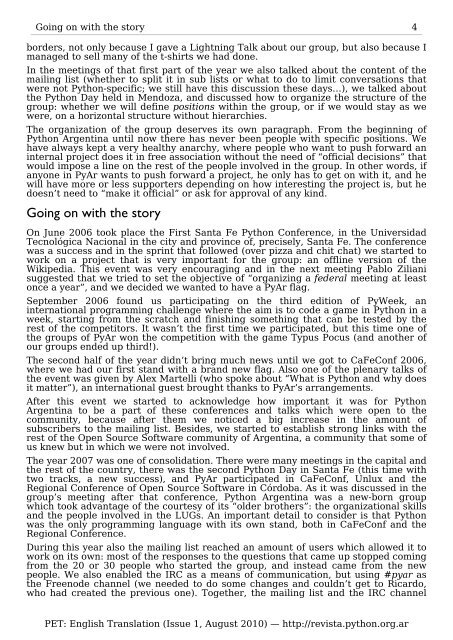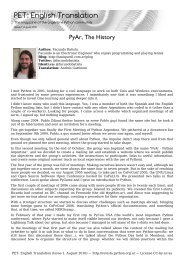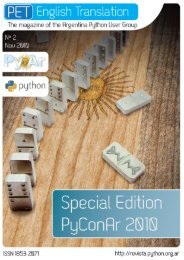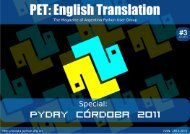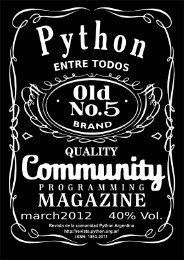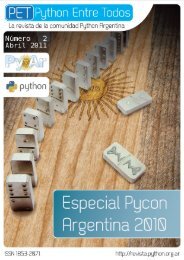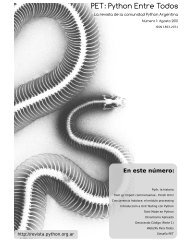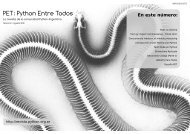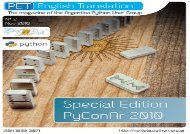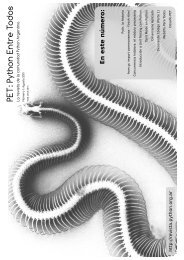A4 portrait - PET: Python Entre Todos - Python Argentina
A4 portrait - PET: Python Entre Todos - Python Argentina
A4 portrait - PET: Python Entre Todos - Python Argentina
Create successful ePaper yourself
Turn your PDF publications into a flip-book with our unique Google optimized e-Paper software.
Going on with the story 4<br />
borders, not only because I gave a Lightning Talk about our group, but also because I<br />
managed to sell many of the t-shirts we had done.<br />
In the meetings of that first part of the year we also talked about the content of the<br />
mailing list (whether to split it in sub lists or what to do to limit conversations that<br />
were not <strong>Python</strong>-specific; we still have this discussion these days…), we talked about<br />
the <strong>Python</strong> Day held in Mendoza, and discussed how to organize the structure of the<br />
group: whether we will define positions within the group, or if we would stay as we<br />
were, on a horizontal structure without hierarchies.<br />
The organization of the group deserves its own paragraph. From the beginning of<br />
<strong>Python</strong> <strong>Argentina</strong> until now there has never been people with specific positions. We<br />
have always kept a very healthy anarchy, where people who want to push forward an<br />
internal project does it in free association without the need of “official decisions” that<br />
would impose a line on the rest of the people involved in the group. In other words, if<br />
anyone in PyAr wants to push forward a project, he only has to get on with it, and he<br />
will have more or less supporters depending on how interesting the project is, but he<br />
doesn’t need to “make it official” or ask for approval of any kind.<br />
Going on with the story<br />
On June 2006 took place the First Santa Fe <strong>Python</strong> Conference, in the Universidad<br />
Tecnológica Nacional in the city and province of, precisely, Santa Fe. The conference<br />
was a success and in the sprint that followed (over pizza and chit chat) we started to<br />
work on a project that is very important for the group: an offline version of the<br />
Wikipedia. This event was very encouraging and in the next meeting Pablo Ziliani<br />
suggested that we tried to set the objective of “organizing a federal meeting at least<br />
once a year”, and we decided we wanted to have a PyAr flag.<br />
September 2006 found us participating on the third edition of PyWeek, an<br />
international programming challenge where the aim is to code a game in <strong>Python</strong> in a<br />
week, starting from the scratch and finishing something that can be tested by the<br />
rest of the competitors. It wasn’t the first time we participated, but this time one of<br />
the groups of PyAr won the competition with the game Typus Pocus (and another of<br />
our groups ended up third!).<br />
The second half of the year didn’t bring much news until we got to CaFeConf 2006,<br />
where we had our first stand with a brand new flag. Also one of the plenary talks of<br />
the event was given by Alex Martelli (who spoke about “What is <strong>Python</strong> and why does<br />
it matter”), an international guest brought thanks to PyAr’s arrangements.<br />
After this event we started to acknowledge how important it was for <strong>Python</strong><br />
<strong>Argentina</strong> to be a part of these conferences and talks which were open to the<br />
community, because after them we noticed a big increase in the amount of<br />
subscribers to the mailing list. Besides, we started to establish strong links with the<br />
rest of the Open Source Software community of <strong>Argentina</strong>, a community that some of<br />
us knew but in which we were not involved.<br />
The year 2007 was one of consolidation. There were many meetings in the capital and<br />
the rest of the country, there was the second <strong>Python</strong> Day in Santa Fe (this time with<br />
two tracks, a new success), and PyAr participated in CaFeConf, Unlux and the<br />
Regional Conference of Open Source Software in Córdoba. As it was discussed in the<br />
group’s meeting after that conference, <strong>Python</strong> <strong>Argentina</strong> was a new-born group<br />
which took advantage of the courtesy of its “older brothers”: the organizational skills<br />
and the people involved in the LUGs. An important detail to consider is that <strong>Python</strong><br />
was the only programming language with its own stand, both in CaFeConf and the<br />
Regional Conference.<br />
During this year also the mailing list reached an amount of users which allowed it to<br />
work on its own: most of the responses to the questions that came up stopped coming<br />
from the 20 or 30 people who started the group, and instead came from the new<br />
people. We also enabled the IRC as a means of communication, but using #pyar as<br />
the Freenode channel (we needed to do some changes and couldn’t get to Ricardo,<br />
who had created the previous one). Together, the mailing list and the IRC channel<br />
<strong>PET</strong>: English Translation (Issue 1, August 2010) — http://revista.python.org.ar


